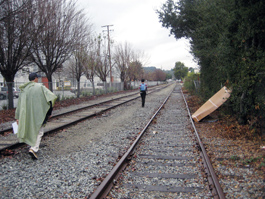home | metro santa cruz index | news | santa cruz | news article

Photograph by Jessica Lussenhop
Trainspotting: Homeless census-takers Jeff (left) and Tracey Heggum make their way down the tracks looking for homeless people. At right, someone has fashioned a cardboard lean-to for the night.
A Fragile Progress
Santa Cruz makes inroads to homelessness--just as hard times hit.
By Jessica Lussenhop
Dawn is still a good two hours away when about 40 volunteers for the 2009 Santa Cruz County Homeless Census show up at the Homeless Community Resource Center. "Good morning," calls Kelly Pleskunas, of Applied Survey Research in Watsonville. "It's not the greatest weather, but we shall persevere."
Pleskunas begins doling out assignments to 52 tracts covering the entire county, where teams will count the number of men, women and children they see who are homeless--before 10am. In the rain.
"Is there anyone here who knows the Pogonip?" she asks. Hands go up. "It's crummy weather. Are you sure you still want to do that?"
"I just came from there," someone yells.
"For an extra 40 bucks," another voice answers.
The jokers are currently homeless and will be guiding volunteers to places only they'd know about--hidden encampments, the inside of a freeway overpass or just someone who doesn't look the part but whom the guide recognizes--all for the reasonable rate of $10 an hour.
For Jeff, who's assigned to downtown Santa Cruz with Tracey Heggum, director of River Street Shelter, the money is pretty crucial. He's been whittling away at the same $30 for a month. As the team sets out along Front Street and under the staircases of the Galleria, Jeff darts down to the ground and back up, seeming to produce a lit cigarette butt out of thin air. "I know that looked sort of ghetto," he says apologetically. "But I'm dirt broke."
"We got the best area, you guys," says Heggum excitedly. "I'm going to see so many people I know."
Ten-Year Plan
Throughout the country, these simple tactics are being used to quantify the homeless in order to qualify for funds from the U.S. Department of Housing and Urban Development. Santa Cruz County typically draws in $1.2 million from the feds, much of which goes to the Santa Cruz County Homeless Action Partnership's Ten Year Plan to End Homelessness.
HAP is made up of an incredible number of agencies and people, including the county; all four cities; HomeBase, a San Francisco public policy firm specializing in homelessness; local philanthropists and businesses and community members.
The 10-year timer officially started in 2003. As the plan hit its five-year mark, another member of Applied Survey Research, Paul O'Brien, was commissioned to take stock of the county's progress. Some of what he found was a pleasant surprise. "Despite all this bummer news, some good things are happening," says O'Brien. "In Santa Cruz County I think there's a lot of compassion around these issues and there's a lot of organizations willing to do something about it."
O'Brien's research found that some goals have already been met or surpassed. The plan was to have 438 emergency beds for wintertime by 2008; in reality 494 were available. It called for 9,627 units of affordable housing by 2013; the county already has 9,298, having surpassed the 2008 goal by 919 units. More homeless people are receiving dental care than expected, and the number of those receiving medical care through the Homeless Persons Health Project grew to 4,563, dwarfing the 10-year goal of 2,500.
"We accomplished more than we realized in the first five years," says Ken Cole, outgoing director of the Homeless Services Center. "Any plan to, quote, end homelessness--none of us really believes that's what we're going to do, but we're going to sure try."
Cole says two shelters built in the last five years, the Pat and Roland Rebele Family Shelter and the Paul Lee Loft Shelter for single men and women, have significantly affected the county's ability to house and help its homeless population, estimated in 2007 to be at 2,789.
He adds, however, that the real struggle is finding permanent housing for people transitioning out of homelessness for good. "That's much, much more difficult to do because of cost of land and zoning restrictions in Santa Cruz County," he says.
Cole says O'Brien's figures have been a welcome ray of sunshine in light of the rising number of people seeking services from agencies like his. The generally accepted figure is 15 percent, a number that could be confirmed by the census when final results are available in April.
Small Blessings
Along the San Lorenzo River, Jeff and Tracey Heggum continue busily scouring the weeds in the dark, looking for human forms.
"Do you want a flashlight?" asks Heggum.
"Your flashlight is actually screwing me up," he says. "I have really good night vision."
There were some mumblings of the count being affected by the bad weather, but Jeff believes it will come out accurately. "Over 45 degrees, a lot of them will stay out," he says. "Then there's the guys that have their liquid blanket. They don't care if it's raining or not. In fact, that's what got me here."
Jeff doesn't mind talking about the serious drinking problem that's landed him on the streets of Santa Cruz for the last five weeks, all the while pointing out people and gamely walking the eight miles to the end of the assigned tract.
"This is tedious, tedious work," says Heggum as the sun gets higher and the 10am deadline closes in.
"Imagine if you were doing this looking for a place to stay," says Jeff.
Send a letter to the editor about this story.
|
|
|
|
|
|